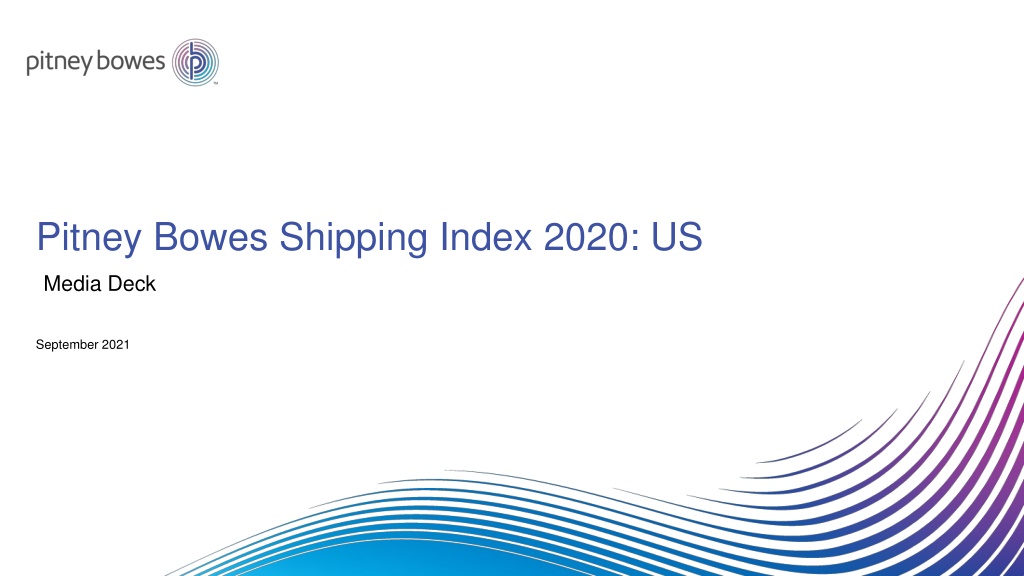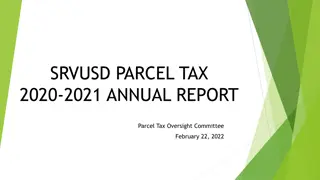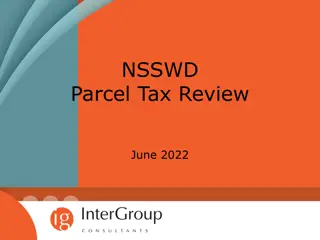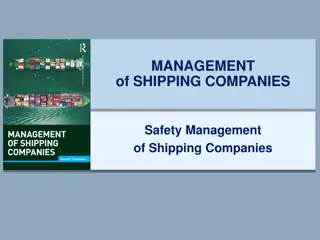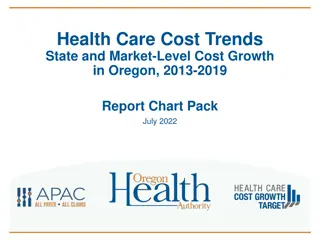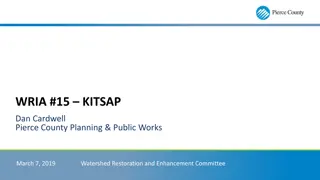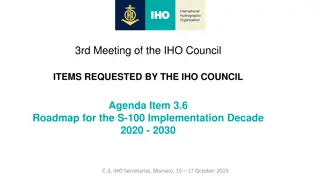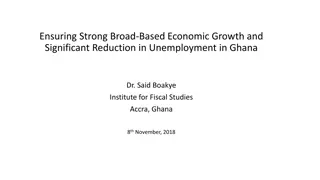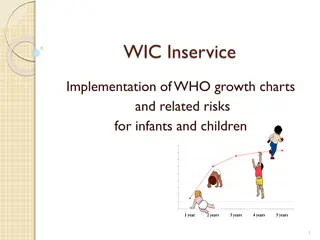Parcel Shipping Trends in the US: Key Insights and Growth Analysis
The US parcel market experienced significant growth in 2020, driven by the surge in e-commerce sales. Parcel volume and revenue showed substantial increases, with Amazon Logistics playing a major role in the market. The top carriers and Amazon Logistics account for a large share of parcel shipments, indicating a highly consolidated market. Forecasts suggest continued growth in parcel volume through 2026, reflecting the evolving dynamics of the US shipping industry.
Download Presentation

Please find below an Image/Link to download the presentation.
The content on the website is provided AS IS for your information and personal use only. It may not be sold, licensed, or shared on other websites without obtaining consent from the author. Download presentation by click this link. If you encounter any issues during the download, it is possible that the publisher has removed the file from their server.
E N D
Presentation Transcript
Pitney Bowes Shipping Index 2020: US Media Deck September 2021
US Parcel Market 2020: Key Insights In 2020, the share of Ecommerce in Retail Sales grew exponentially: US Retail Sales (Excluding Autos, Gas, Restaurants/Bars and Grocery Stores) increased by 5.7% and the Ecommerce share of this grew from 19.6% in 2019 to 24.5% in 2020 In 2020, US parcel volume increased by 37%, from 14.7B in 2019 to 20B in 2020 Amazon Logistics accounted for 20% or 4.2B parcels of the total volume Amazon Logistics market share in parcel revenue was 10% of total US parcel revenue market Amazon Logistics volume doubled: from 1.8B parcels in 2019 to 4.2B parcels in 2020 US parcel market is highly consolidated: the top three carriers and Amazon Logistics account for 99% of US parcel shipments by volume USPS (38%), UPS (24%), Amazon Logistics (21%), and FedEx (16%). Amazon Logistics generated significant growth of 135% CAGR in volume from 2016-2020 at 71% CAGR in parcel revenue growth during the same timeframe US parcel volume is forecast to nearly double from 20.1B in 2020 and reach 32B-39B parcels by 2026, with a 10% CAGR for 21- 25 In 2020, US shipped 640 parcels every second, compared to 466 in 2019 and 317 in 2015 Parcels per capita increased from 45 in 2019 to 61 in 2020 Between 2015 and 2020, US parcel volume doubled: from 10B parcels to 20B parcels Pitney Bowes Shipping Index 2020 2
Parcel Market Size United States Parcel Revenue ($ B) 2014-20 CAGR (2014-20) 2014 2015 2016 2017 2018 2019 2020 CAGR (2014-20); 11.10% $180.0 B 11.00% $171.4 B Parcel Revenue $160.0 B 9.00% $140.0 B 11.1% $ Billion $91.14 B $95.42 B $104.49 B $115.15 B $125.98 B $132.40 B $171.39 B $132.4 B $120.0 B $126.0 B YOY Growth (%) 4.7% 9.5% 10.2% 9.4% 5.1% 29.4% $115.2 B 7.00% $100.0 B $104.5 B $95.4 B $91.1 B Parcel Volume $80.0 B 5.00% $60.0 B 13.8% Parcel Shipments (B) 9.28 B 10.03 B 10.90 B 12.00 B 13.26 B 14.75 B 20.18 B $40.0 B 3.00% YOY Growth (%) 8.1% 8.7% 10.0% 10.6% 11.2% 36.9% $20.0 B Parcels per Capita $0.0 B 1.00% 2014 2015 2016 2017 2018 2019 2020 13.1% Parcels per Person 29.2 31.3 33.8 36.9 40.6 44.9 60.9 Parcel Volume (B) 2014-20 YOY Growth (%) 7.3% 7.9% 9.3% 10.0% 10.6% 35.5% CAGR (2014- 20); 13.82% 25.0 B Revenue per Parcel 13.00% -2.4% USD $9.82 $9.51 $9.58 $9.6 $9.5 $8.98 $8.49 20.0 B 20.2 B 11.00% YOY Growth (%) -3.2% 0.8% 0.1% -1.0% -5.5% -5.4% 9.00% 15.0 B 14.7 B 13.3 B 7.00% 12.0 B 10.9 B 10.0 B 10.0 B 9.3 B 5.00% 5.0 B 3.00% 0.0 B 1.00% 2014 2015 2016 2017 2018 2019 2020 Pitney Bowes Shipping Index 2020 3
Parcel Revenue & Market Share United States CAGR (2014-20) 2014 2015 2016 2017 2018 2019 2020 Parcel Revenue ($ B) 6.2% UPS $41.77 B $41.94 B 0.4% $43.59 B 4.0% $46.51 B 6.7% $49.81 B 7.1% $52.15 B 4.7% $59.99 B 15.0% Parcel Market Share, by Revenue 2020 YOY Growth (%) 10.1% FedEx $32.80 B $34.83 B 6.2% $38.55 B 10.7% $41.81 B 8.4% $45.09 B 7.9% $46.22 B 2.5% $58.34 B 26.2% Others 1% YOY Growth (%) 14.7% USPS $14.29 B $15.59 B 9.1% $17.63 B 13.1% $19.83 B 12.5% $22.17 B 11.8% $23.29 B 5.0% $32.54 B 39.7% UPS 35% YOY Growth (%) Amazon Logistics 10% 71.2% Amazon Logistics $0.71 B $1.43 B 100.0% $2.95 B 106.3% $5.09 B 72.7% $6.82 B 34.1% $8.58 B 25.8% $17.97 B 109.4% YOY Growth (%) 8.3% Others $1.58 B $1.64 B 3.9% $1.77 B 8.0% $1.92 B 8.4% $2.08 B 8.3% $2.16 B 3.9% $2.55 B 18.0% USPS 19% YOY Growth (%) 11.1% Total $91.14 B $95.42 B 4.7% $104.49 B 9.5% $115.15 B 10.2% $125.98 B 9.4% $132.40 B 5.1% $171.39 B 29.4% YOY Growth (%) FedEx 34% Change Market Share (2014-20) -10.8% 46% 44% 42% 40% 40% 39% 35% UPS 36% 37% 37% 36% 36% 35% 34% -1.9% FedEx 16% 16% 17% 17% 18% 18% 19% 3.3% USPS 1% 1% 3% 4% 5% 6% 10% 9.7% Amazon Logistics 2% 2% 2% 2% 2% 2% 1% -0.2% Others Total 100% 100% 100% 100% 100% 100% 100% Figures may not sum due to rounding Pitney Bowes Shipping Index 2020 4
Parcel Volume & Market Share United States CAGR (2014-20) 2014 2015 2016 2017 2018 2019 2020 Parcel Volume (B) 5.1% UPS 3.64 B 3.69 B 1.3% 3.83 B 3.9% 4.01 B 4.5% 4.13 B 3.0% 4.37 B 6.0% 4.92 B 12.6% Parcel Market Share, by Volume 2020 YOY Growth (%) 7.9% FedEx 2.06 B 2.17 B 5.0% 2.28 B 5.2% 2.35 B 3.2% 2.52 B 7.2% 2.67 B 6.0% 3.25 B 21.7% Others 1% YOY Growth (%) 14.3% USPS 3.40 B 3.97 B 16.7% 4.50 B 13.3% 5.10 B 13.5% 5.66 B 11.0% 5.67 B 0.2% 7.60 B 34.0% UPS 24% YOY Growth (%) 135.3% Amazon Logistics 0.02 B 0.06 B 137.0% 0.14 B 137.0% 0.38 B 170.1% 0.78 B 109.1% 1.85 B 135.7% 4.20 B 127.0% Amazon Logistics 21% YOY Growth (%) 5.8% Others FedEx 16% 0.15 B 0.15 B 1.0% 0.15 B 5.6% 0.16 B 4.3% 0.17 B 5.2% 0.18 B 5.3% 0.20 B 13.9% YOY Growth (%) 13.8% Total 9.28 B 10.03 B 8.1% 10.90 B 8.7% 12.00 B 10.0% 13.26 B 10.6% 14.75 B 11.2% 20.18 B 36.9% YOY Growth (%) Change USPS 38% Market Share (2014-20) -14.9% 39% 37% 35% 33% 31% 30% 24% UPS 22% 22% 21% 20% 19% 18% 16% -6.1% FedEx 37% 40% 41% 43% 43% 38% 38% 1.0% USPS 0% 1% 1% 3% 6% 13% 21% 20.5% Amazon Logistics 2% 1% 1% 1% 1% 1% 1% -0.6% Others Total 100% 100% 100% 100% 100% 100% 100% Figures may not sum due to rounding Pitney Bowes Shipping Index 2020 5
The pandemic has resulted in parcel volume surge and carriers have imposed peak surcharges and capped the daily delivery volumes Impact of Covid-19 on the US parcel industry: The pandemic has led to fluctuating parcel industry tendencies in the US due to the staggering growth of Ecommerce and physical movement restriction around the globe and has put up unprecedented challenges for parcel delivery players In April 2020, USPS extended its priority mail and first-class package service from two and three-day service commitments to three and four days, respectively In June 2020, Amazon suspended its delivery services in the US due to rising customer orders and requirement of workforce and capacity to handle the order surge USPS hired more than 50,000 temporary workers and increased more than 10,000 positions in full-time staffing to deal with a 40% increase in parcel volume during the holiday season and workforce shortage due to covid-19 illness. In July 2021, FedEx suspended its money-back guarantee for all FedEx express services which was reinstated in April 2021 and readjusted its signature guidelines to reduce physical contact Pitney Bowes Shipping Index 2020 Sources: Logistics Management 6
Significant investment in parcel delivery capabilities to accommodate the growing demands Overall US retail sales grew by 3.1% YoY driven by Ecommerce sales, further propelling the parcel market forward In 2020, Ecommerce sales in the US grew at 31.7 % YoY, reaching $759.4 billion triggered by the physical restrictions imposed by the government to curb the global pandemic According to the US Department of Commerce, US Ecommerce sales accounted for 13.6% of total US retail sales in 2020 as compared to 11% in 2019. US Retail Sales (Excluding Autos, Gas, Restaurants/Bars and Grocery Stores) grew 5.7% and the Ecommerce share of this grew from 19.6% in 2019 to 24.5% in 2020. Multiple players have capitalized on the rapidly increasing Ecommerce growth in the US o Amazon's US revenues represent more than one third (34.7%) of total US Ecommerce sales o Walmart's Ecommerce net sales expanded by 78.4% YoY reaching $43 billion in 2020, driven by larger basket size and extended operational hours in November 2020 In Q1 21, the US Ecommerce sales increased by 39.1% compared to the same quarter last year, rendering that the pandemic induced effects haven t faded away Significant expansion of in-house delivery in response to booming parcel volume Amazon: In 2020, Amazon logistics delivered 4.2 billion packages, an increment of 127% YoY through its in-house delivery network in the US o In 2020, Amazon expanded its physical footprint of fulfilment and data centers in the US by 52.6% YoY in response to the Covid-19 led boom in Ecommerce o Amazon s global shipping costs continued to surpass sales growth and increased at 61.1% YoY in 2020, while revenue increased by 37.6% YoY o In 2021, Amazon plans to open 85 new fulfilment and distribution centers in the US, with a focus on providing customers with quick delivery o In January 2021, Amazon purchased 11 aircrafts for its in-house delivery network from Delta and WestJet to fulfill the operational requirement generated due to increased Ecommerce volume. Pitney Bowes Shipping Index 2020 Sources: US Department of Commerce, Digitalcommerce360, Amazon Annual Report, Walmart Annual Report 7
World Appendix Pitney Bowes Shipping Index 2020 8 8
Definitions US Parcel Market Sizing: for the period 2012-20, calculate market size of parcel shipments in the US, in terms of: Parcel volume Parcel revenue Market shares for the top three carriers US Parcel Market Forecast: for the period 2021-26, forecast parcel volumes Definitions Parcels are defined as domestic and international outbound (from respective country to international destination) shipments that do not require special handling (for country wise detailed definition of parcel please refer to the appendix section) Carrier revenue includes the cost to ship an item from its point of origin to point of destination, and margins charged by the carrier. This does not include the price value of the item being shipped Carriers tracked include incumbents/large players such as FedEx, UPS, USPS etc., retailer owned delivery networks such as Amazon Logistics Pitney Bowes Shipping Index 2020 9
Forecast Methodology Global Parcel Volume Forecast 2021 2026 Methodology Forecasted Retail Sales and estimated share of Ecommerce Estimated Parcel Volume for every country and by carrier, including Amazon Logistics Estimated parcel volume using ratio of updated parcel volume vs. prior Shipping Index parcel volume Date Sources: US Census Bureau Retail Sales Date Sources: The Colography Group. US Parcel volume actuals are available through 2020 APEX Global Parcel report (2020) GDP Forecasts (FocusEconomics) eMarketer Forrester IDC 10
